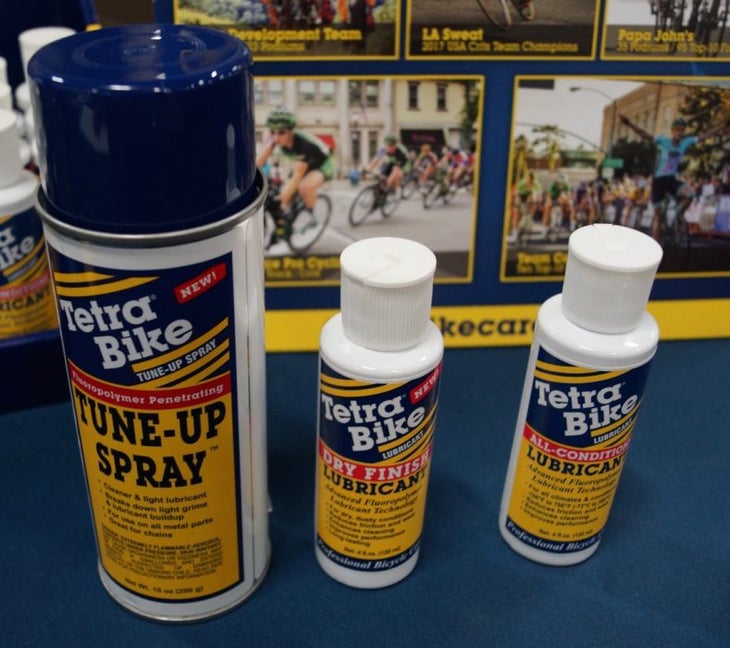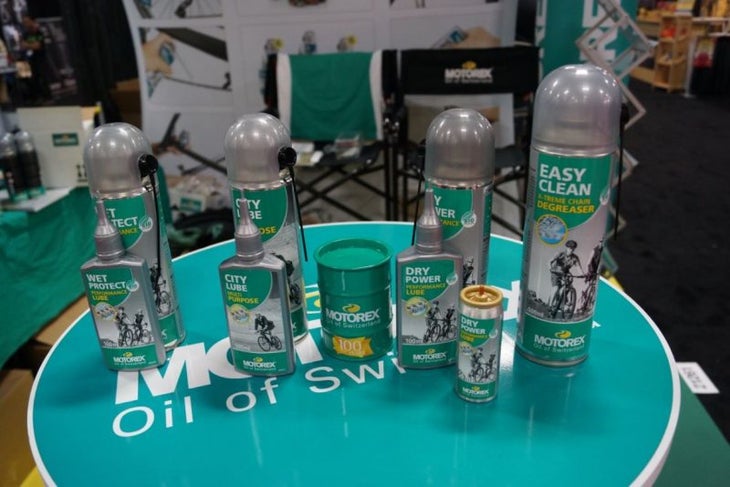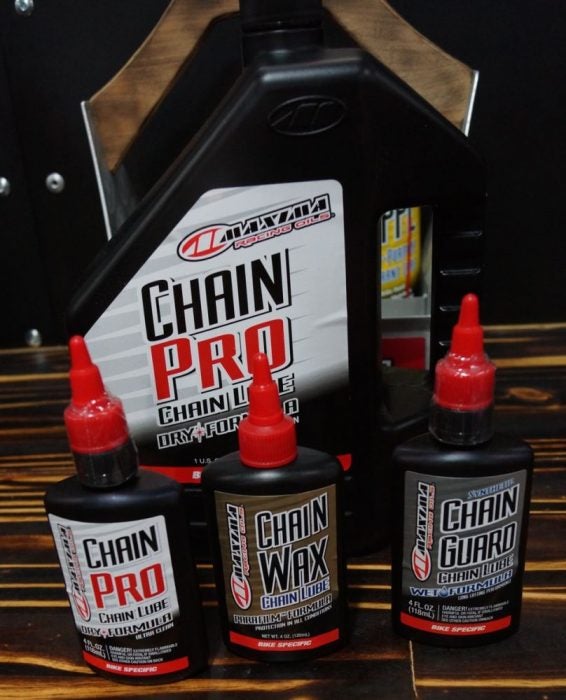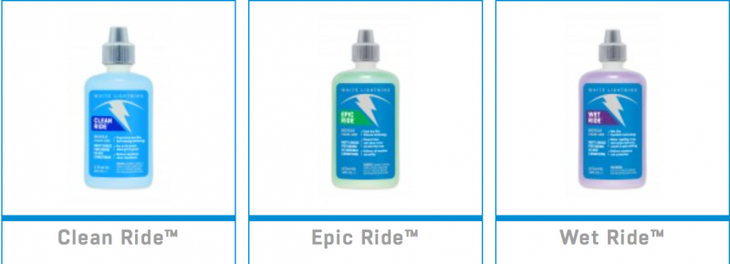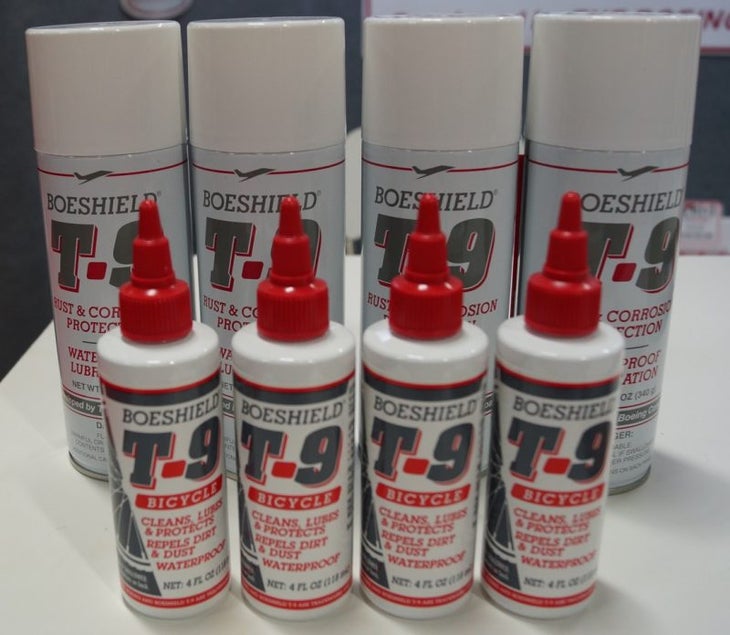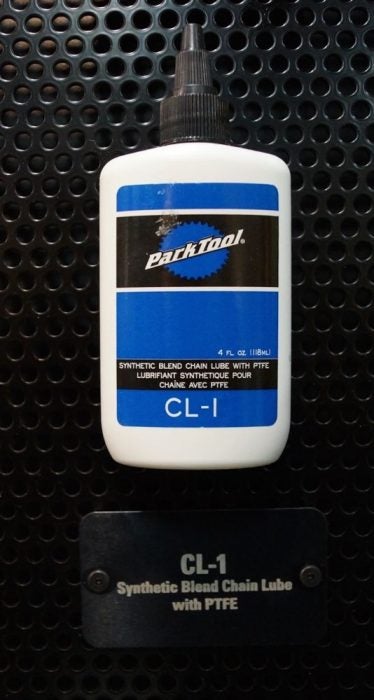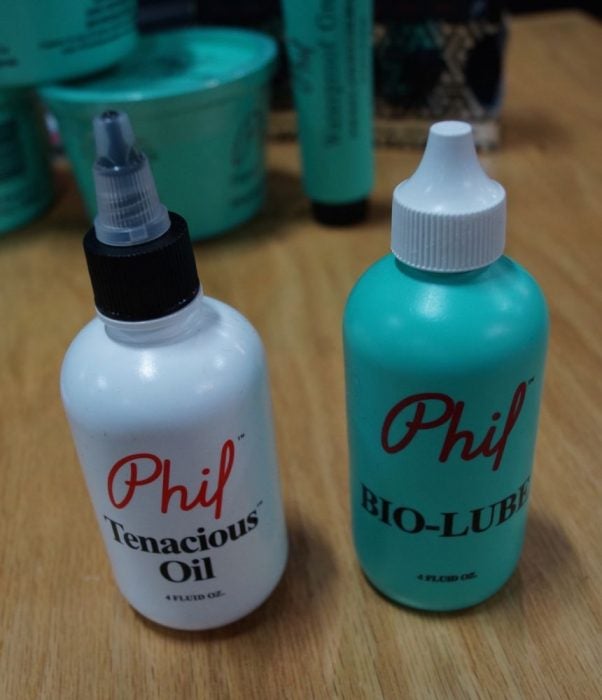Heading out the door? Read this article on the new Outside+ app available now on iOS devices for members! Download the app.
All cyclists beyond the most casual ones are consumers of chain lubricant. And anyone who has bought chain lube knows that there is a vast array of choices.
But how do you choose?
How about “eeny, meany, miny, mo”? Are they all the same thing in different packages? And what do want your lube to do? Stop your chain from squeaking? Protect your chain? Keep your chain clean enough that you won’t get a Cat 5 tattoo on your calf if you touch it against the chain? Have the lowest friction? Stay on the chain through hours of riding in the rain? Require reapplication as seldom as possible?
I endeavored at this Interbike show to understand more about chain-lube technology and find out who’s doing what, and why. Each manufacturer was eager to espouse the advantages of its lubes and many were also quite happy to call BS on the claims of other lube makers. I left less certain of what to choose than when I started and with a deep respect for the dedication of lube companies to producing the best product they can.
Even though the Interbike of 2017 is considerably smaller than what it once was, it still is one of the best opportunities to talk to such companies. There are over 50 different lubes between the Friction Facts chain-lube test we published in VeloNews and those shown in the graph in UK lube maker Muc-Off’s promotional material, but only seven of those included lube manufacturers had booths at the 2017 Interbike show, namely: Muc-Off, Motorex, Finish Line, White Lightning, Park Tool, Phil Wood, Boeshield T-9, and Tetra Bike. Additionally, two more that are not on either graph, namely Maxima and Tetra Bike, were at the show, also with compelling stories to tell.
Furthermore, I recently visited Ceramic Speed’s US facility in Boulder, CO, which includes an expanded version of the Friction Facts test lab; in 2016, Ceramic Speed purchased Friction Facts and hired its founder, Jason Smith, as its chief technology officer.
1. Finish Line
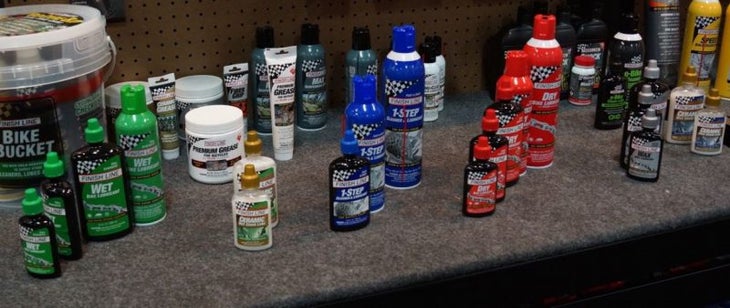 Finish Line founder, president, and CEO Henry Krause claims to have been the first (30 years ago) to focus on chain lubes for bicycles with a product range to encompass a variety of conditions. In 1988, to address the desires of mountain bikers to not have their chains pick up so much dirt, he developed the first dry lube for bike chains. He now offers six different lubes, with that one, called Dry, still in the line.
Finish Line founder, president, and CEO Henry Krause claims to have been the first (30 years ago) to focus on chain lubes for bicycles with a product range to encompass a variety of conditions. In 1988, to address the desires of mountain bikers to not have their chains pick up so much dirt, he developed the first dry lube for bike chains. He now offers six different lubes, with that one, called Dry, still in the line.
Finish Line’s wet lube is a blend of synthetic oil for use in wet conditions. Krause created Wax lube to answer White Lightning’s sudden grab of market share with its patented self-shedding wax-based dry lube that kept the chain super clean; he added molybdenum and Teflon to make the paraffin slipperier and to slide dirt off, all in a fast-evaporating heptane carrier keeping them in solution. Ceramic wet lube has tiny, boron-nitride balls to roll against the chain’s sliding surfaces, while Ceramic Wax is for dry conditions that Krause claims floats out gray residue after riding on the first few applications that is grime from deep in the metal’s pores that even chain cleaners can’t get out. Both Ceramic lubes are the white color of the boron-nitride particles. Finally, 1-Step is a chain cleaner and lube in one for the rider who has an interest in a clean, lubricated chain (it leaves a “clean film” of lube on the chain) but no interest in spending much time or energy on it.
All Finish Line bottled lubes come with child-resistant caps.
2. Muc-Off
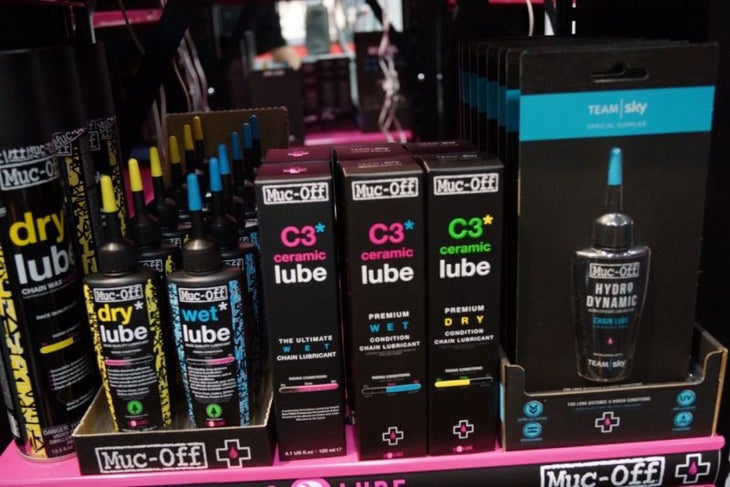
Muc-Off has been making bike-care products for 12 years. Since 2015, it has been the lube of Team Sky, and it treated 75 chains for the 14 British track riders for the 2016 Olympics, all of whom medaled, netting 12 medals, six of them gold. It has an aerospace engineer, Dr. Martin Mathias, running its development lab, which includes sound-analysis equipment and the C.L.O.D. (Chain Lube Optimization Dynometer) chain-friction testing machine that it claims cost 100,000 pounds sterling.
Muc-Off offers nine (yes, nine!) different chain lubes and, like Ceramic Speed, also sells optimized Dura-Ace chains that have been pre-sorted for smoothest operation, ultrasonically cleaned, and then dipped in a special sauce to make the lowest-friction chain it claims that money can buy. In 2015, it prepared the Dura-Ace chain for Sir Bradley Wiggins’s hour record, which it called the “6,000-pound ($8,000) Nanotube Chain” and, in the endless pursuit of watts savings, also ran-in his chainrings on the C.L.O.D. Muc-Off claims that 0.337km of Wiggins’s 54.526km were because of its efforts.
Muc-Off made its hydrophobic Hydrodynamic Lube at the request of Team Sky for more durability when racing in the rain. Its Ceramic C3 Dry Lube contains tiny boron nitride ceramic balls and is claimed to provide “total corrosion protection and unparalleled performance in dry, dusty, and damp conditions.” A UV dye is added to the lube, and each bottle comes with a tiny UV light dangling from its neck which the user shines on the chain to ensure that every link is coated.
Ceramic C3 Wet Lube has boron nitride ceramic balls and fluoropolymers in oil for durability. Dry Lube has PTFE (Teflon) in wax; Bio Dry Lube is oilier and designed for extreme conditions; Bio Wet Lube, made from natural ingredients and renewable sources, is for rain and mud; -50C Chain Lube is designed to prevent freezing of links in super cold conditions. Finally, Nanotube Chain Lube is a bottled version of the dipping sauce for its friction-optimized chains with minuscule graphene (carbon) tubes in it; it is intended to re-lube one of those pricey chains and still stay within 1-2 watts of its original frictional drag.
Muc-Off claims that its optimized Nanotube Chain (NTC) starts out at the same frictional drag (a bit over 4 watts) as Ceramic Speed’s optimized UFO chain, but that the NTC’s drag drops over four hours to under 4 watts while the UFO’s goes way up, to over 14 watts. It claims its Nanotube lube goes 400km per application.
3. Ceramic Speed
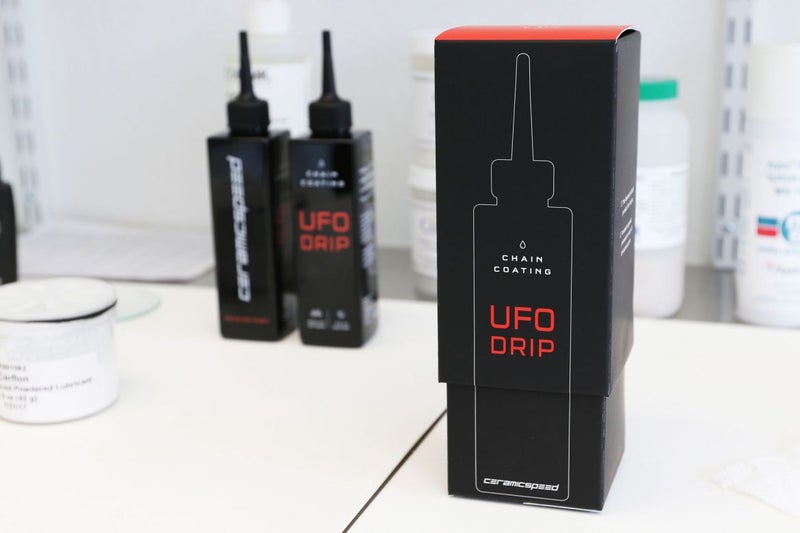
In his Friction Facts work as an independent friction-testing lab, Jason Smith developed ideas of how to make chains (bearings, too) faster, and he implemented them by offering the first optimized chains (ultrasonically-cleaned Dura-Ace chains dipped in molten paraffin blended with other slippery ingredients). He has continued that work as CTO of Ceramic Speed and has developed a drip lube, UFO Drip Chain Coating, that he claims is the fastest on the market. It is a thin lube with paraffin and other ingredients in a solvent suspension. I have been using it for a month or so, and it is on my travel bike here at Interbike. I don’t like having a dirty chain in my travel case, and this lube certainly keeps it clean, at least in dry and dusty conditions. It picks up little or no dirt when riding on dirt roads, and it seems to spin fast and runs quietly.
Ceramic Speed claims to be the “only facility with all friction-testing equipment under one roof” and to be the “only manufacturer who has the capability to friction-test so comprehensively in support of a new product.” It still offers UFO optimized Dura-Ace chains, and it claims that UFO Drip Chain Coating has lower friction than any other drip-on chain lube.
In its Boulder facility, Ceramic Speed performs durability testing in the lab with sand, water, salt water, high temperatures, and low temperatures, as well as puts chains on its chain-friction-testing machine before and after extended periods of riding outdoors in varying conditions. It also performs sound analysis of drivetrains. It claims that its UFO drip lube has 20 percent lower friction (measured in watts) than the second-place lube (which it says is Squirt) before riding, and 83 percent lower after riding. It also claims to have measured a 46-percent reduction in drivetrain wear for its (dry) UFO drip lube compared to “wet lubes.”
4. Tetra Bike
Tetra Bike is a division of New Jersey-based FTI, a creator of full-synthetic fluoropolymers since the 1980s, and, among other products, it makes lubricants for firearms. Claiming that, “We’re the technological difference,” sales manager Steve Hoback points out that firearms have to deal with many of the same conditions that bikes do—dust, sand, rain, mud, cold, not to mention very high heat, and they need to be reliable so the gun won’t jam.
FTI/Tetra Bike general manager Greg Cohen is generally dismissive of the testing and technology of other lubricant makers in the bike industry relative to FTI’s. He says that nanotubes in lubes are nonsensical, claiming that FTI has tested them and that they make no difference in a lube, being too small to do anything useful, and that they are far too expensive and largely unobtainable to use in a chain lube. He also claims that ceramic in a lubricant is nonsensical, because ceramics are abrasive. Cohen’s further position is that having more than two different lubricant formulations in a bike-lube line is vaporware—that all you need is one for wet and one for dry.
Both of Tetra Bike’s lubes have PTFE in them, but Cohen claims that the moniker “Teflon” only applies to PTFE that is in sheets or flakes, whereas the PTFE in his lubes are rounded, 4-micron particles produced by sintering and pressurized milling. He claims that those rounded particles fill voids in the metal, stay there tenaciously due to ionic bonding, are soft and give, unlike rigid ceramic particles, and the myriad of them on both surfaces allow those surfaces to slide across each other with lower friction. The PTFE particles are suspended in green odorless mineral spirits, which evaporates more slowly than the volatile solvents used by other manufacturers, thus allowing time to spread around to all of the sliding surfaces. He claims that Dry Finish lube and the more viscous All Condition lube contain 20-22 percent PTFE, whereas all that is required by law to dub a lube as “Teflon” is 3 percent PTFE.
5. Motorex
Motorex is celebrating its 100th anniversary this year; it started with shoe polishes. Dry Power is a synthetic oil with paraffin in it. It has no additives (solvents or carriers) and is biodegradable. City Lube is for e-bikes and is intended to deal with the higher torque the motor adds to leg power. It is stickier (hence more drag) for durability and has Teflon and other high-wear additives. Wet Protect is a biodegradable synthetic oil engineered for high durability in rainy riding.
Not having specifically child-resistant caps on its bottles, its caps do terminate in a thin tube whose tip you snip off, and the base of the cap, rather than unscrewing, acts as a valve that you turn to different positions to meter the flow. Motorex is Swiss, and, like many Swiss companies, is interested in minimizing waste and pollution. Its small aerosol cans are refillable from larger aerosols, at home or at a retailer, and its lubes are available in shop sizes as well as giant drums. To change between lubes depending on conditions, it recommends first spraying on biodegradable Motorex Easy Clean and wiping off the excess before applying the new lube.
6. Maxima
Maxima is a 38-year-old San Diego-based company making bike lubes the past three years and whose roots are in the motor-sports industry with a focus on racing and performance. It makes everything in-house, including bottling. It claims a lot of technology in synthetic oils, which, at least in grade-five synthetics, are completely man-made, engineered lubricants produced for a certain application, like long molecules that interlock or slide across one another, by combining acids and alcohols. Some Maxima synthetics, for instance, protect high-performance engines in the event of a catastrophic loss of oil due to a leak; its additives adhere to the metal and keep the pistons sliding in the cylinders. Similarly, it makes synthetic oils to increase compression and hence horsepower by making the piston rings lose less pressure past them.
Maxima’s marketing manager says that what the best chain lube depends on what the consumer is looking for, noting that it’s a tradeoff and that no lube can be simultaneously the lowest in friction and also highly durable. Maxima Chain Wax is designed to stay cleaner during use, utilizing paraffin and other additives in a heptane carrier; its utility is enhanced on a dirty ride by applying it well prior to the ride to allow the carrier to distribute the paraffin into the chain’s tiny crevices. Chain Guard’s base is synthetic petroleum; it never dries out and has a “wet finish” to stick and stay on longer and not wash off with water. Maxima claims that Chain Pro is the “lightest, cleanest chain lube.” After the heptane carrier evaporates, it leaves a PTFE (Teflon) reside and feels dry; it has the least longevity of any Maxima lubricant.
The latest Maxima bottles incorporate child-resistant caps.
7. White Lightning
White Lightning became immediately known for a top layer that sheds off along with dirt and keeps the chain clean. Of course, since it sheds off, it lacks durability. Now owned by Finish Line, it has three lubes. Clean Ride is its original product, now with Teflon added, and is intended for dry conditions. Epic Ride is a semi-dry lube with Teflon in it that is claimed to last longer than wax lubes. Wet Ride attracts more dirt than other White Lightning lubes but lasts longer and has rust inhibitors.
White Lightning has child-resistant caps on all of its lube bottles.
8. Boeshield T-9
Boeshield T-9 was developed by Boeing for high-penetration lubrication needs on airplanes. It is thin, so it penetrates, and it dries completely. There is only one version of it, in both drip bottles and aerosol spray. “It is a great product for all conditions,” says sales manager Tom Habers. “One product does it all.”
Habers claims that Boeshield T-9 is waterproof and rust protective and can be used on cables and as a frame saver. Habers claims that this same formulation has been used in the marine industry for 35 years, making it great for bikes used in coastal areas.
9. Park Tool
Park also has just one chain lube, CL-1, and it is a wet lube. Sales manager John Krawczyk says, “We believe that a wet lube protects better and has more longevity.”
CL-1 is a vegetable-based, biodegradable oil base dissolved in a mineral-spirits carrier, because it is too thick to apply without the solvent. Krawczyk says that the carrier does some cleaning while spreading the lube on the chain, so a quick wipe after application is recommended.
10. Phil Wood
Phil Wood now has a second lube, Bio Lube, to join Phil Tenacious Oil, which has been sold in its original formula since 1972. Tenacious Oil is a “good, tacky oil,” according to Phil VP Garrett Enright. “It’s good on hot days and cold ones, and in mud and snow; it stays on in all conditions,” he says.
Bio Lube, on the other hand, is a lighter, thin, plant-based lubricant with no solvent. Enright claims that Bio Lube is so thin that it will flush out contaminants between chain rollers and pins. He also says that its manufacturer does recycling of oil from restaurants, and the smell of Bio Lube varies. “Sometimes it smells like French fries,” he says.
So what lube to get? You know more about chain lubes now, but your decision may not have become any easier. If you’re looking for straight speed, this won’t settle the question, because at least three of these companies, Tetra Bike, Muc-Off and Ceramic Speed, claim to have the lowest-friction lubes on the market and claim to have test data to prove it. If you’re looking for drivetrain protection, you’ll have to sift through whose claims you want to believe. In any case, understand that each lube has a range of conditions it is best for, and use that as a guide to determine what makes the most sense for where you ride your bike.
